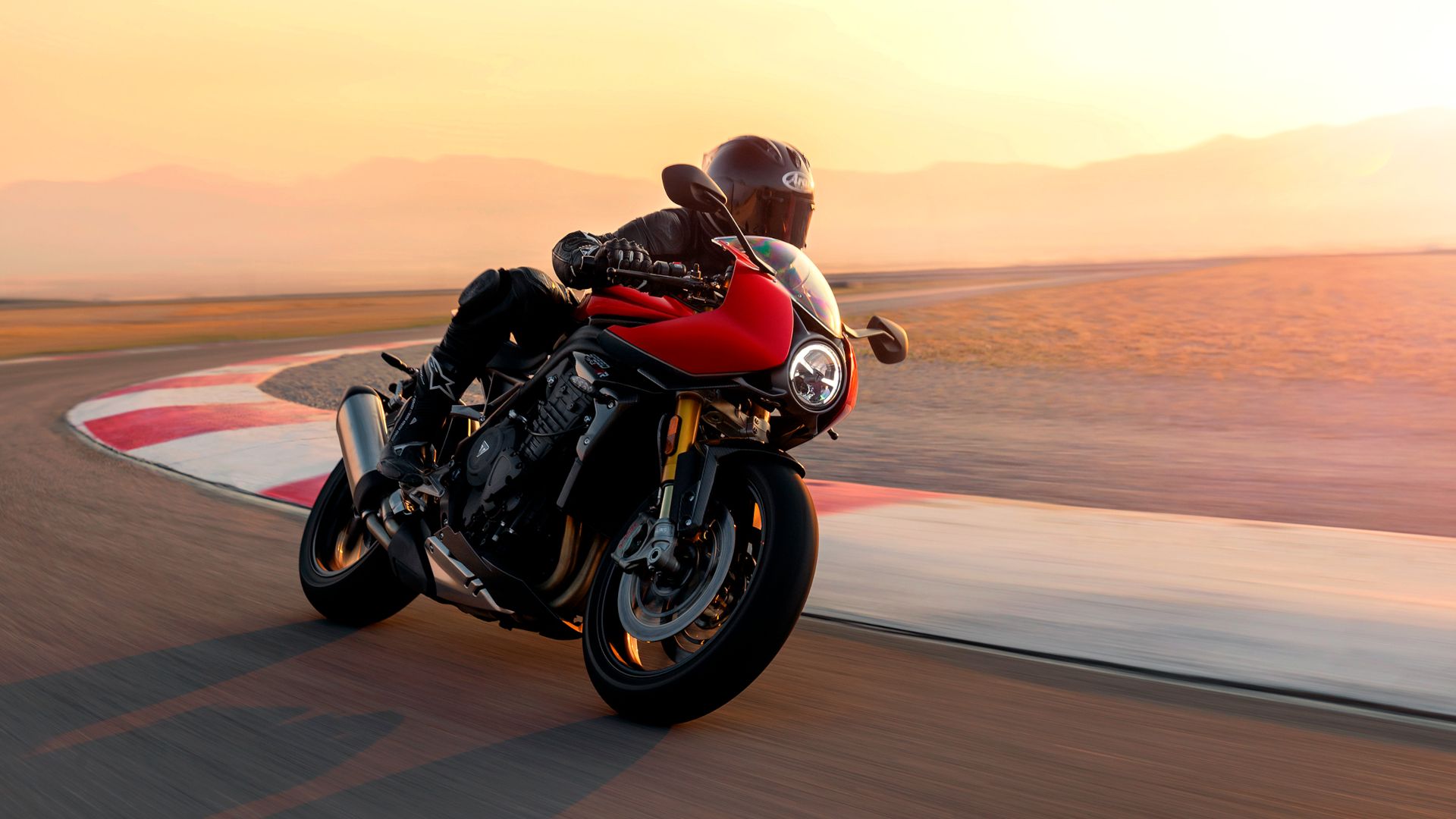Beware of the motorcycle rider that tells you that Triumph builds nothing but boring, unreliable retro bikes, for they know not of what they speak. They must have it confused for some other (former) British brand. Sure, it may be true that when John Bloor revived the manufacturer in the early 1980s, he'd inherited a rusty, outdated mess. The British motorcycle industry took quite the beating in the decades prior, from the much more competitive, reliable, and cheap Japanese motorcycles like the Honda CB750. But Bloor had his eyes firmly set on the future, and when he finally had his modern manufacturing facilities, engineers, and designers squared away, he fired off a shot that reverberates in the motorcycle industry to this day.
While the three-cylinder engine has been around, at least in cars, since the 1950s, and though Moto Guzzi gave it a shot before World War II, it was Triumph that had the earliest success with a triple in its original Trident, produced from 1968 to 1975. That machine, like many British bikes of the time, had a host of problems, though it was successful enough to be made for at least seven years or so. But it wasn't until Bloor's factory started pumping out Daytonas and Street Triples that the funky engine finally found its true purpose.
Three Cylinders Are Faster Than Two
We'll likely never really know what John Bloor had in mind when he rescued Triumph from receivership. But by the time the early 1990s rolled around, and Triumph pushed out the latest versions of the Trident and the Spirit, no one was really using three-cylinder engines. So perhaps it was not only a nod to its past, but also a real pragmatic approach to entering a new market, namely the sport segment, that drove Triumph to use three cylinders. How else could Triumph compete, and set itself apart with industry giants like The Big Four, who were dominating the scene with Ninjas and Gixxers?
The triple offered one solution. By adding an extra cylinder, the bike could produce more power. It was as simple as that. And by the time the Daytona Super III rolled onto the track, the redesigned engine was pumping out a claimed 115 horsepower. It had a limited production run, helped along by a collaboration with Cosworth, and proved to the world, once and for all, that Triumph could compete with other sport bike makers.
Three Cylinders Are Also Better Than Four
Triumph's triple engine has gone through a lot of changes in the modern era. It has been upsized and downsized on numerous occasions. And though the Rocket III, with its 2458-cc triple engine, is one heck of a beast on the scale, the majority of the triple family can be lighter than comparative four-cylinder models from other manufacturers, while providing the same if not better specifications.
We don't blame you for being skeptical. But take BMW's S 1000 R as an example. It's a similar roadster to the Triumph Speed Triple RS. It's not quite a sport bike, missing all the prerequisite fairings, but it's no slouch in the speed department, delivering 165 hp from its 999-cc inline-four engine. Its weight, including the M-package, is 438 pounds, ready to roll. In comparison, the Triumph Speed Triple RS has higher displacement of 1160-cc in its three cylinders, which pumps out 177 horsepower and weighs in at 437 pounds. The same weight and one less cylinder, which gives a smoother ride, and yet it produces more horsepower than the BMW.
Standing Out In Crowd
We don't like to admit this as motorcycle riders, but we do care about what our peers think about our bikes. Our choice of a motorcycle can say a lot about us. And we can definitely feel a certain way about those that ride Harleys, Kawasakis and BMWs, to name a few. But nothing sets you apart from the rest than a motorcycle with an odd number of cylinders. V2s are well known. So are the inline-two and four bikes. But there aren't that many triples out there. Yamaha makes them, as does MV Agusta. But none are as smooth in their fueling and power delivery as Triumph's well-engineered triples.
The Heart And Soul Of Moto2
Perhaps nothing speaks more of the Triumph triple cylinder's reputation than the fact that MotoGP decided to use them in their Moto2 series. That means every single participating team built their bikes around it. To achieve the best possible results and make it even more reliable and exciting for the race setting, the 765 triple was completely retuned and reworked for use on the track. That's not an easy task, as there are many differences between racing and riding on the street. The engine had to be made tougher, for higher RPMs, with a taller first gear, tunable slipper clutch, and a reprogrammed race-specific ECU. In addition, the engine sported brand-new components. New crank, pistons, aluminum barrels, and titanium valves were introduced to make sure the engine was ready to tackle multiple trips around the track without breaking down.
Triumph has been partnering with MotoGP since 2019, and there seems to be great mutual admiration, as the two have extended that partnership to 2024. It has proven to be a fruitful endeavor for Triumph especially, as the triple engine had broken many lap records throughout its use since 2019, including the first ever 187 mph top speed in the history of Moto2 by Stefano Manzi. But regardless of whether the triple is used on tracks around the world, or on the streets in your own town, it will always be known as a unique and reliable engineering marvel.




